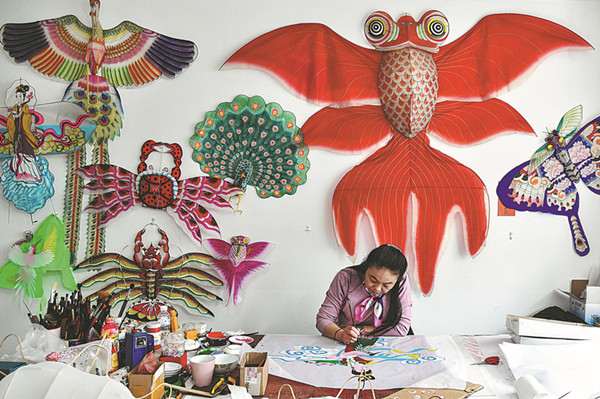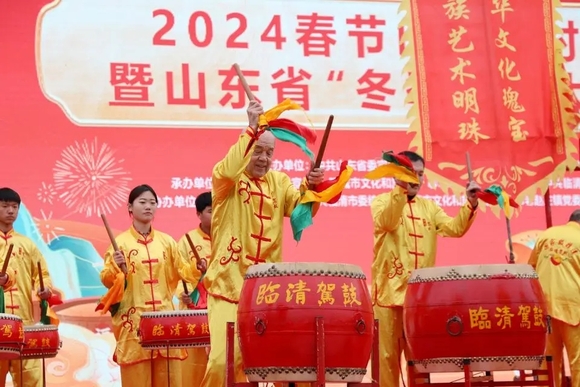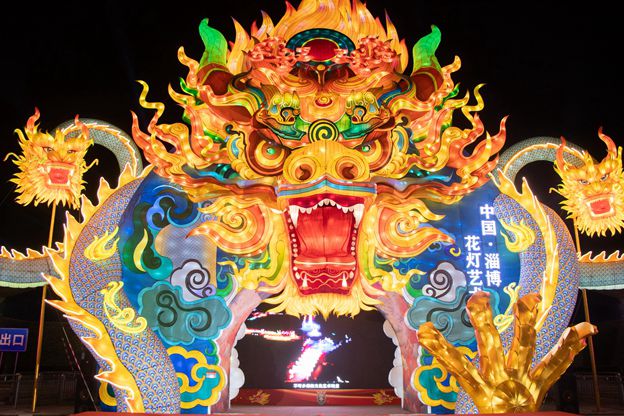World kite capital set to soar with rich heritage, industry advantages
(China Daily Global)| Updated : 2022-05-19
Print Print
Yang Hongwei, an intangible cultural heritage inheritor of Weifang kite-making in Yangjiabu village in Weifang, paints a kite in April 2021. Yang learned kite-making from her grandfather in 1982 and has shown her skills in cities such as Beijing and Shenzhen, Guangdong province, as well as internationally. ZHU ZHENG/XINHUA
Editor's Note: This series of stories looks at local enterprises in specialized sectors that have a share in global markets.
In April, crowds in Weifang, Shandong province, looked to the skies in awe.
High above them, "spacecraft" reenacted the breakthrough docking procedure that had set a milestone in China's space program.
The spectacle was complete with a station module and an astronaut spacewalk, all made up of a huge, complex structure of kites soaring on the wind.
The China Space Station kite-put together by more than 20 craftsmen over two months and combining traditional techniques with state-of-the-art digital modeling technology-went viral online.
"From superheroes to dinosaurs, in Weifang, anything can fly in the sky," one netizen gushed.
Weifang is widely known as the world's kite capital. The city acknowledges this with kite-themed landmarks including a railway station depicting a fluttering butterfly, public sculptures portraying the popular pastime, and streetlights along the main thoroughfare leading to the sprawling venue for an annual international kite festival.
At Weifang Kaixuan Kite Manufacturing Co, workers make kites ranging from gleaming airplanes and beautiful landscape paintings to lifelike marine creatures, such as whales and octopuses.
"More than 95 percent of these kites are exported and have been sold in more than 40 countries and regions, including New Zealand, France and Denmark," company Chairman Wang Xiaoping said.
"When we exhibit our kites abroad, we say we are from Weifang. Foreigners know it as the kite capital of the world, and our products are very popular with them."
According to local historical records, Weifang kites were popular during the Ming Dynasty (1368-1644) and were a major folk art in the Qing Dynasty (1644-1911), with many artists becoming widely known for their exquisite, high-flying creations.
Weifang kites took off after the country's reform and opening-up. In 1984, its kites were sent to Shanghai to take part in an exhibition, impressing officials of an international kite association who immediately suggested that the city set up a global platform for the art. This led to the first Weifang International Kite Festival that same year.
Kite enthusiasts from 11 countries and regions participated in the event and were amazed by the intricacy, vividness and grandeur of Weifang kites.
The city's kite sector has continued to grow, with the festival being held every year since 1984. There are currently more than 400 kite companies in the city, and they employ more than 80,000 people. Each year, more than 220 million kites are made, with annual sales of more than 2 billion yuan ($297 million), according to municipal authorities.
"Weifang kites account for more than 75 percent of the international kite market and nearly 85 percent of the domestic market," said Zhang Jianwei, director of the comprehensive service center at the Weifang International Kite Association.
At least 29 kite export companies are registered in the city, with markets on five continents.
Wang, chairman of Weifang Kaixuan Kite Manufacturing, said that in 2002, the company exported about 100,000 kites, mostly simple ones with small, triangular frames that cost about 10 yuan. The company now exports millions of kites of all makes and sizes each year, Wang said. A premium kite can cost more than 7,000 yuan.
"All kinds of kites are exported and most of them are used by children," Wang said. They are mainly made of carbon fiber and nylon and have sturdy frames.
Many kites in foreign countries are used not just as toys but also for advertising purposes, so there is great demand, Wang said, adding that the company can fill orders from multinationals for more than 100,000 kites each.
"Weifang's kites not only bring economic benefits to the local people, they also carry traditional Chinese culture to the world," Wang said.
A traditional Weifang kite is made of bamboo and features Chinese painting. Traditional kite-making focuses on the four arts of tying (using bamboo for a frame), pasting (placing paper, silk and other material onto the frame), painting and "letting go" (flying). In 2006, Weifang kites were added to China's intangible cultural heritage list.
Yang Hongwei, 56, is a leading inheritor of Weifang's kite tradition. Yang, who was born into a kite-making family, often saw up close the brightly colored kites of different shapes and sizes in her grandfather's workshop. At the age of 16, she learned kite-making skills from her grandfather, and after 10 years' practice of the craft, Yang set up her own workshop in 1992.
"Many parts of the world have a tradition of flying kites, but I think the cultural background behind our kites is unique," Yang said.
Yang's creations include common butterfly and swallow patterns, as well as patterns and images from Chinese mythology, legends and history.
She once made a kite painted with a phoenix head, adding to it the painted portraits of 50 famous Chinese women through history. Each woman had her own characteristics in appearance, clothing and makeup, Yang said.
In order to create the portraits, Yang spent a lot of time checking historical records and discussing details with specialists.
"It's very time-consuming," Yang said. "But when I explain our kite story to foreign guests, I get a great sense of accomplishment."
Yang has also traveled to countries including Germany, Australia, the United States and New Zealand to share with people there the Chinese stories related to kites and to teach them the traditional craft.
Community effort
Weifang's villagers are also reaping the rewards of the kite industry. The city's Wangjiazhuangzi village is known as the "No 1 Kite Village in China". There are more than 100 enterprises there engaged in kite-making, with many villagers involved in processing kite fabric and the kites' hand-held line wheels.
The village reports an annual output of more than 90 million kites at a value of 300 million yuan, accounting for more than 80 percent of Weifang's total kite sales.
From design and raw materials to accessories and tying, the village has formed a relatively complete industrial chain. There are 4,700 people in Wangjiazhuangzi, nearly 3,000 of whom are engaged in kite or kite-related sectors. Many others take part when farm work takes less time, said Wang Zhenhua, a Party official of Wangjiazhuangzi.
Villager Sun Yuemei works at the Dashan kite factory, which has been operating for 16 years. It employs more than 30 people and has an annual output value of up to 3 million yuan.
During peak production season, workers use sewing machines and reinforced plastic material to come up with colorful kites to fill orders.
"It's the peak season now," Sun said last month. "Basically, there are orders from all over the country every day. Up to tens of thousands of kites are needed. We work overtime to catch up."
Wang Zhenhua, the Party official, said that the village's traditional bamboo-woven kites have a history of hundreds of years, but the first Weifang International Kite Festival in 1984 truly became the village's business card. Its kites are now sold all over the country and exported to the US, Iran, South Korea, Japan and other parts of the world, he said.
The kites are constantly being updated, with their materials becoming more environmentally friendly and the colors even richer, Wang said. For example, most of the materials used in the past were paper or plastic cloth, but fabrics for down jackets and umbrellas are among the materials now used. Previous kite patterns were all painted, but now 3D digital printing and heat transfer technology are used, he said.
"These materials are environmentally friendly and durable," Wang said.
In recent years, with the improvement of brand awareness and scientific and technological advances, Weifang kites have continued to focus on innovation, aiming for high-quality development. Producers use laser cutting and digital design technologies to make the kites more attractive.
Weifang kites have evolved into thousands of types, with the smallest a little more than 10 square centimeters and the largest spread over 3,600 square meters.
Wang Xiaoping, the chairman of Weifang Kaixuan Kite Manufacturing, said he believes that the core competitiveness of Weifang's kites lies in innovation. Foreign kites are also becoming more sport-oriented and specialized, such as those used for kite-surfing and paragliding, representing development trends that should be closely tracked, he said.
"You can't build a kite behind closed doors," Wang said. "We conduct market research every year, not only to learn from advanced concepts at home and abroad, but also to maintain traditional Chinese characteristics and find a fit between the two."

 2024 Shandong Rural Cultural and Tourism Festival
2024 Shandong Rural Cultural and Tourism Festival  Celebrate Spring Festival in Zibo
Celebrate Spring Festival in Zibo  Share your views on 2024 China's govt work report
Share your views on 2024 China's govt work report